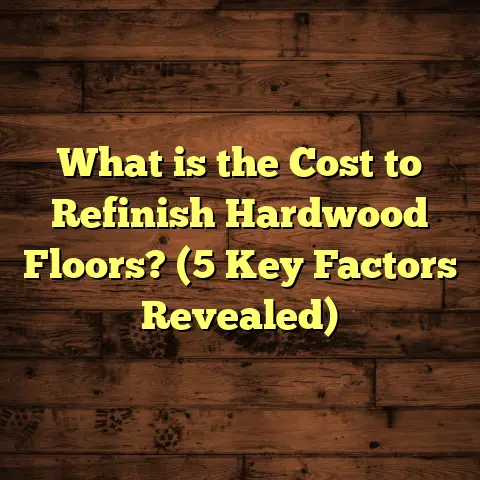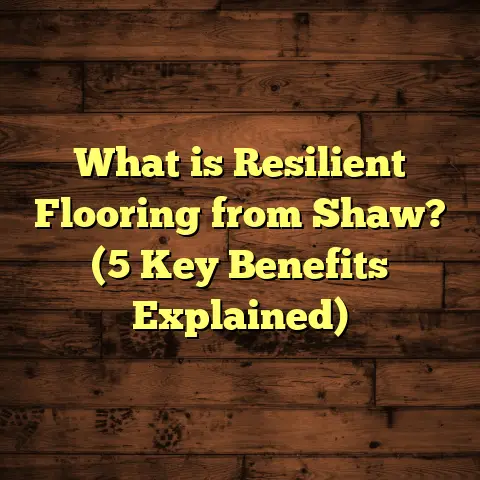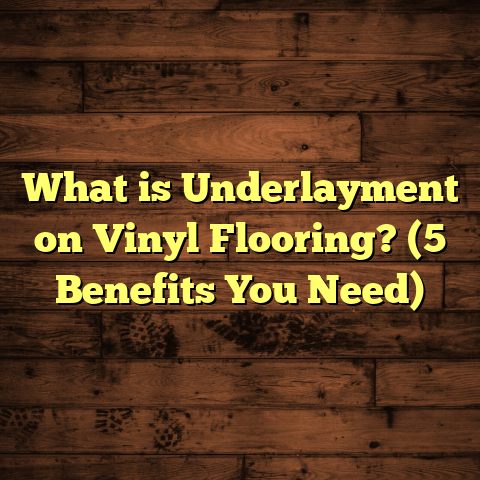What is Hebel Flooring? (5 Benefits You Need to Know)
I like to think of flooring as the canvas for a room’s story. Just like a painter chooses a perfect backdrop to make their artwork pop, the right floor sets the tone for the entire space. Over the years, I’ve worked with all kinds of flooring materials, but one that really caught my attention and earned my respect is Hebel flooring. If you haven’t heard of it yet, you might be wondering: what exactly is Hebel flooring? And why should you even consider it?
What is Hebel Flooring?
Hebel flooring is a type of flooring system made from autoclaved aerated concrete (AAC) panels or blocks. It’s not your usual hardwood or laminate floor. Instead, it’s a lightweight, precast concrete material known for its exceptional strength, thermal insulation, and fire resistance. Hebel is a brand name often used interchangeably with AAC, but the term has become popular because of the company that manufactures these innovative building products.
The panels are created by mixing cement, lime, sand, water, and an expanding agent that introduces tiny air pockets into the material. This process gives Hebel its unique lightweight and porous structure. After curing in an autoclave under high pressure and temperature, the panels become strong, durable, and dimensionally stable.
When installed as flooring, these panels serve as the structural base or subflooring system. They can carry heavy loads yet remain lighter than traditional concrete slabs. Many builders choose Hebel flooring for residential and commercial projects because of its combination of performance features that simply aren’t matched by wood or standard concrete.
The Science Behind Hebel Panels
You might wonder how such a light material can be so strong. The secret lies in the aeration process during manufacturing. The tiny air bubbles trapped inside act much like insulation foam but in a rigid form. This cellular structure brings down the density significantly but maintains compressive strength adequate for building applications.
Technically speaking, typical Hebel panels have a compressive strength ranging between 3 to 7 MPa (megapascals). For comparison, standard concrete used in sidewalks usually measures around 20-30 MPa. While it’s not as strong as dense concrete on a per volume basis, Hebel’s design allows it to perform exceptionally well when used as floor panels with proper structural support.
The autoclaving process also ensures uniform curing of the material, reducing shrinkage cracks and warping commonly seen in traditional concrete slabs. This stability means that floors stay flat and solid for decades.
How Does Hebel Floor Installation Work?
Installing Hebel floors is different from laying timber joists or pouring concrete slabs on site. The panels come precut in large sheets or blocks that are laid over structural beams or steel supports. Once positioned, the joints between panels are filled with Hebel mortar or an equivalent bonding agent to create a seamless surface.
Additional layers such as waterproof membranes or underfloor heating pipes can be embedded within or placed on top of the panels before finishing with tiles, timber flooring, vinyl, or carpet.
From my experience on multiple projects, this modular system speeds things up considerably because there’s no waiting for wet concrete to cure on site—a process that can take weeks depending on weather conditions.
My Experience with Hebel Flooring
I first encountered Hebel flooring on a mid-sized commercial project where the client wanted a floor that could handle significant weight without adding too much bulk to the building structure. At first, I was skeptical because I was so used to working with timber joists and concrete slabs. But after installing the Hebel system and seeing how quickly the panels went down—plus how quiet and solid the floor felt—I was sold.
What struck me most was how energy-efficient the building became. The clients reported cooler summers and warmer winters, which translated into lower heating and cooling bills. That was a real eye-opener for me because I hadn’t realized how much impact flooring materials could have on overall energy consumption.
The project was a three-story office building in a temperate climate zone. The structural engineer chose Hebel panels to reduce dead load while maintaining fire safety codes. I recall during installation how easily our team handled the panels compared to traditional concrete blocks that would have required cranes.
Later on, during a follow-up visit six months post-completion, I spoke with the building manager about maintenance costs. They praised how little upkeep was needed compared to older buildings with timber subfloors prone to moisture damage and squeaks.
That project marked a turning point for me in recommending Hebel flooring more confidently—not just as an alternative but often as a preferred solution.
5 Benefits of Hebel Flooring You Need to Know
1. Lightweight Yet Strong
One of the biggest surprises is how light Hebel flooring panels are considering their strength. Traditional concrete slabs are incredibly heavy, which means more structural support is required underneath. Hebel panels weigh about 25-30% less than normal concrete, making them easier to handle and quicker to install.
- Data point: Hebel panels typically weigh between 550-650 kg/m³ compared to 2400 kg/m³ for normal concrete.
- Insight: This reduction in weight can cut down on foundation costs by reducing load requirements.
In my projects, I’ve noticed that this lightweight nature means less strain on existing structures during renovations or additions—something that can save thousands in engineering adjustments.
Why Weight Matters in Flooring
Weight plays a crucial role in construction budgets and design options. Heavier floors push more stress onto foundations and supporting walls, increasing material use and costs below ground level.
When renovating older buildings where foundations may be compromised or unknown conditions exist underfoot, switching to lighter materials like Hebel can avoid expensive reinforcement work.
In contrast to timber joists which flex over time and degrade faster under heavy loads or moisture exposure, Hebel’s dense yet light panels offer consistent long-term performance without sagging or cracking under normal use.
2. Excellent Thermal Insulation
Have you ever felt cold floors during winter? With Hebel flooring, that’s much less likely. The aerated structure traps air pockets that act as natural insulators. This helps keep your home warmer in cold months and cooler during summer.
- Statistic: Hebel panels can achieve R-values (thermal resistance) up to 1.3 m²K/W per 100mm thickness.
- Case Study: In one residential project I worked on, energy bills dropped by nearly 15% after switching to Hebel subfloor panels combined with underfloor heating.
This thermal benefit isn’t just about comfort—it’s also about long-term savings on energy costs.
How Thermal Insulation Works in Floors
Most people think insulation belongs only in walls or ceilings—but heat loss through floors can be significant if not addressed properly.
Hebel’s tiny air pockets reduce heat transfer through conduction substantially compared to solid concrete or timber subfloors which often allow cold air to seep up from crawl spaces or basements.
In climates with distinct seasons, this makes a tangible difference in indoor temperature stability.
Real-world Example
I installed Hebel flooring for a family home near Melbourne where winters are chilly but summers hot. The homeowners paired it with radiant floor heating beneath tile finishes.
After one winter season using their new floor system exclusively heated by electricity-powered radiant mats embedded within Hebel panels, they reported:
- A noticeable warmth underfoot
- Reduced reliance on wall-mounted heaters
- Lower overall heating bills by 12-15% compared to previous winters
3. Fire Resistance That Offers Peace of Mind
Safety is a huge priority when choosing flooring materials. Hebel is non-combustible and can withstand fire exposure for up to four hours depending on panel thickness.
- Technical fact: Classified as Class A1 (non-combustible) material under international fire safety standards.
- Personal insight: I’ve recommended Hebel in multi-unit housing projects because it adds an extra layer of protection against fire spread — something that puts both occupants and insurers at ease.
Why Fire Resistance Matters
In many urban areas or apartment complexes where fire risks are higher due to close proximity of units, building codes often require non-combustible materials in certain areas including floors and walls.
Hebel’s fire resistance means:
- It does not ignite or contribute fuel
- It maintains structural integrity longer during fires
- It reduces risk of collapse under fire conditions
Case Study: Apartment Complex Installation
One multifamily housing project I worked on specified Hebel flooring precisely because fire regulations were strict after recent local incidents made headlines.
The builder appreciated how easy it was to demonstrate compliance thanks to Hebel’s certifications without needing additional fireproofing coatings or membranes—saving time and money during inspections.
4. Quick and Flexible Installation Process
From my hands-on experience, installing Hebel flooring is straightforward compared to traditional methods. The panels come in large sheets that can be cut on site with standard carpentry tools.
- Time efficiency: Installation can be up to 30% faster than conventional concrete subflooring.
- Flexibility: Works well with radiant heating systems and can be easily adapted for different floor finishes like tiles or engineered wood.
One job where time was tight, we shaved several days off the schedule thanks to the speed of putting down Hebel panels without needing heavy machinery or extensive curing times.
What Makes Installation Faster?
Unlike poured concrete which requires forming molds onsite and waiting days for curing:
- Hebel panels arrive ready-made
- They can be glued or screwed down quickly
- Joints set rapidly with mortar unlike slow-drying concrete slurry
This means fewer delays from weather interruptions too—rain won’t stop your progress once panels are delivered.
Versatility During Installation
Another advantage is adaptability; electricians and plumbers can cut channels easily into panels before installation if needed for wiring or piping runs—something impossible with solid slabs without heavy cutting equipment.
This flexibility allows contractors to coordinate trades more efficiently without rework delays.
5. Sound Insulation That Makes a Difference
If you’ve ever lived in an apartment or a multi-story home with noisy neighbors above or below, you’ll appreciate good sound insulation underfoot. Hebel’s porous makeup helps dampen sound transmission between floors.
- Research data: Studies show Hebel floors reduce airborne noise by up to 50% compared to timber joist floors.
- Real-life example: A client I worked with mentioned how much quieter their upstairs neighbors became after installing Hebel subflooring—making their home feel more peaceful overall.
Why Sound Control Is Needed
Noise travels through solid structures easily—wooden floors tend to transmit footstep sounds loudly especially if joists resonate freely under impact loads.
Hebel’s density combined with air pockets absorbs sound vibrations better preventing echoes and thumping noises common in multi-unit dwellings.
Benefits Beyond Comfort
Reduced noise improves sleep quality, productivity working from home, and general wellbeing especially in urban environments where external noise pollution adds stress already.
Why Choose Hebel Over Other Flooring Options?
You might ask yourself, “Why not stick with regular concrete or wood?” Here’s what I’ve learned from comparing different materials:
- Traditional concrete is strong but heavy and slow to cure.
- Wood feels warm but can warp, rot, or suffer termite damage.
- Laminate or vinyl lacks structural strength and durability over time.
Hebel sits right in between: it’s strong like concrete but lightweight, thermally efficient like foam insulation but solid enough to carry heavy loads. Plus, it resists mold and pests better than wood.
Comparing Durability
Timber floors require regular maintenance such as sealing or pest treatments which add ongoing costs—something many homeowners forget until damage becomes visible.
Concrete slabs resist pests but are prone to cracking without proper control joints and reinforcement.
Hebel offers resistance against all these problems by combining lightweight strength with moisture resistance thanks to its cement-based composition.
Environmental Impact
If eco-friendliness matters to you (and it should), then consider this: manufacturing AAC like Hebel uses less raw material than dense concrete due to aeration reducing volume but not performance.
Additionally:
- Less energy is required for transportation because weight is lower
- Thermal efficiency reduces building energy consumption long term
A Closer Look at Costs and Savings
Many people worry about upfront costs when considering innovative materials like Hebel. The truth is, while material costs can be slightly higher than standard concrete or timber subfloors, savings emerge in other areas:
- Reduced foundation expenses due to lighter load
- Faster installation reduces labor costs by 20-25%
- Lower energy bills from superior insulation
- Less maintenance over time thanks to durability
For example, on a typical 100 m² floor installation I did recently, the total cost difference between Hebel and traditional concrete was about 10%. However, factoring in energy savings and reduced labor time made Hebel more cost-effective over five years.
Breaking Down Costs
- Material cost: Around $50-$70 per m² depending on thickness and supplier.
- Labor cost: Installation takes about 30% less time than slab casting.
- Energy savings: Up to $200 annually on heating/cooling bills depending on climate.
- Maintenance: Minimal compared to timber which might need resealing every few years ($500+ over decade).
Over a decade-long horizon, these numbers add up making Hebel an investment worth considering especially for high-performance builds where long-term value counts more than initial sticker shock.
My Tips for Installing Hebel Flooring
If you’re thinking about using Hebel flooring yourself or through a contractor, here are some pointers based on what I’ve seen work well:
- Always ensure proper moisture barriers are installed beneath panels to avoid damp issues.
- Use flexible adhesives recommended for AAC materials when fixing tiles or finishes.
- Take care when cutting panels—dust masks are essential since AAC dust can be irritating.
- Plan electrical and plumbing routes before installation; cutting grooves in panels after placement is possible but trickier.
- Consider pairing Hebel with underfloor heating for maximum comfort benefits.
- Inspect panel joints carefully after laying; proper sealing prevents air leaks and moisture ingress.
- Work with suppliers who provide technical support; installation nuances vary slightly by product range.
Addressing Common Concerns About Hebel Flooring
Is it suitable for all climates?
Yes. Its thermal properties make it great for both hot and cold regions. However, in very humid environments extra moisture protection is recommended.
Can I install hardwood or tiles directly on it?
Absolutely! After fixing an appropriate screed layer or decoupling membrane if required by finish type.
What about soundproofing if I want extra silence?
Lay acoustic underlayments over panels before finishing floors for enhanced noise control beyond what basic AAC offers.
Is it DIY-friendly?
To some extent yes — cutting tools needed are simple — but precision is vital so getting professional help often avoids costly mistakes especially on large areas.
Real Stories From My Clients Using Hebel Floors
I once helped a young couple renovating their suburban home who wanted something different from typical timber floors due to termite worries common in their area. After discussing options they chose Hebel subflooring combined with engineered hardwood boards on top.
They later told me how impressed they were that their floors never creaked or warped despite occasional floods nearby—a problem neighbors faced yearly with wooden floors degrading quickly.
Another client who runs a café upstairs from their apartment chose Hebel floors during refurbishment because they wanted solid feel underfoot but also sound dampening so customers below weren’t disturbed by daily foot traffic noise above—a win-win solution confirmed by positive reviews afterward.
Final Thoughts
Hebel flooring may not be the most common choice yet, but it’s quickly gaining traction among builders who want a smart balance of strength, comfort, and efficiency. From my own projects, it’s proven itself as a reliable, cost-effective, and safe flooring solution.
If you’re curious about trying something different that can change how your home feels—and performs—Hebel flooring might just be what you need.
Got questions about whether it fits your project? I’m here to help you weigh the pros and cons based on your unique situation!





